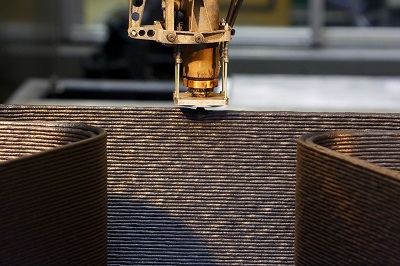SABIC introduced to the European market a family of high-performance THERMOCOMP™ AM compounds to address the unique requirements of large format additive manufacturing. At Formnext 2017, the company exhibited eight new compounds, developed for use in large-format pellet-fed extruders. Print parameters and mechanical property data for the materials – developed by SABIC using test specimens printed on the company’s in-house BAAM® printer – were available to aid customers in expediting material selection and optimizing processing conditions. Because they are reinforced with carbon or glass fibers for added strength, the new THERMOCOMP™ AM compounds can be used for demanding applications in the tooling, aerospace, automotive and defense industries.
SABIC’s first eight reinforced THERMOCOMP™ AM compounds for large format additive manufacturing are based on four of the company’s amorphous resins: acrylonitrile-butadiene-styrene (ABS), polyphenylene ether (PPE), polycarbonate (PC) and polyetherimide (PEI). These resins exhibit good creep behavior versus semi-crystalline resins, and reduced deformation under constant pressure. Further, these materials exhibit lower shrinkage during cooling, which means greater dimensional stability and less thermal expansion during part use.
ABS-based compounds provide ease of processing, low warpage and good print surface quality, making them good candidate materials for a broad range of applications and tooling, including thermoforming and vacuum forming. PPE-based compounds offer lower thermal expansion, outstanding hydrolytic stability, a higher strength-to-weight ratio and higher temperature performance compared to ABS. PC-based compounds deliver higher stiffness, higher temperature performance and higher throughput compared to ABS and PPE, as well as excellent ductility and a smooth surface finish. PEI-based compounds, developed from SABIC’s inherently flame-retardant ULTEM™ resins, provide low thermal expansion, high temperature performance, an excellent strength-to-weight ratio, high modulus and low creep.
Each of the THERMOCOMP™ AM materials is reinforced with carbon or glass fiber, depending on the degree of stiffness and dimensional stability required. As adoption of large format additive manufacturing increases, SABIC plans to expand its THERMOCOMP™ AM portfolio and other material offerings to meet evolving customer needs.

SABIC showcased at Formnext a section of a yacht hull from Livrea Yacht that was printed on the company’s BAAM machine in its Center of Excellence for Additive Manufacturing in Pittsfield. The hull is a result of a collaborative design effort between SABIC, Livrea Yacht and 3D design and engineering software provider, Autodesk. Using Autodesk® Fusion 360® design software and SABIC’s processing expertise on the BAAM equipment, the three companies selected two materials from the THERMOCOMP™ AM portfolio: a carbon fiber-reinforced PPE compound for the hull’s outer layer, and a carbon fiber-reinforced PEI for the inner lattice support structure.
The process of using large-format additive manufacturing enabled Livrea Yacht to eliminate the need for molds and prototyping, which can be costly and inefficient. The 3D printed hull is lighter and stronger, and can be manufactured at a fraction of the cost and in half the time, giving Livrea Yacht a competitive breakthrough that would not be possible with traditional fabrication.
Adidas
 iConnectHub
iConnectHub
 Login/Register
Login/Register Supplier Login
Supplier Login



























